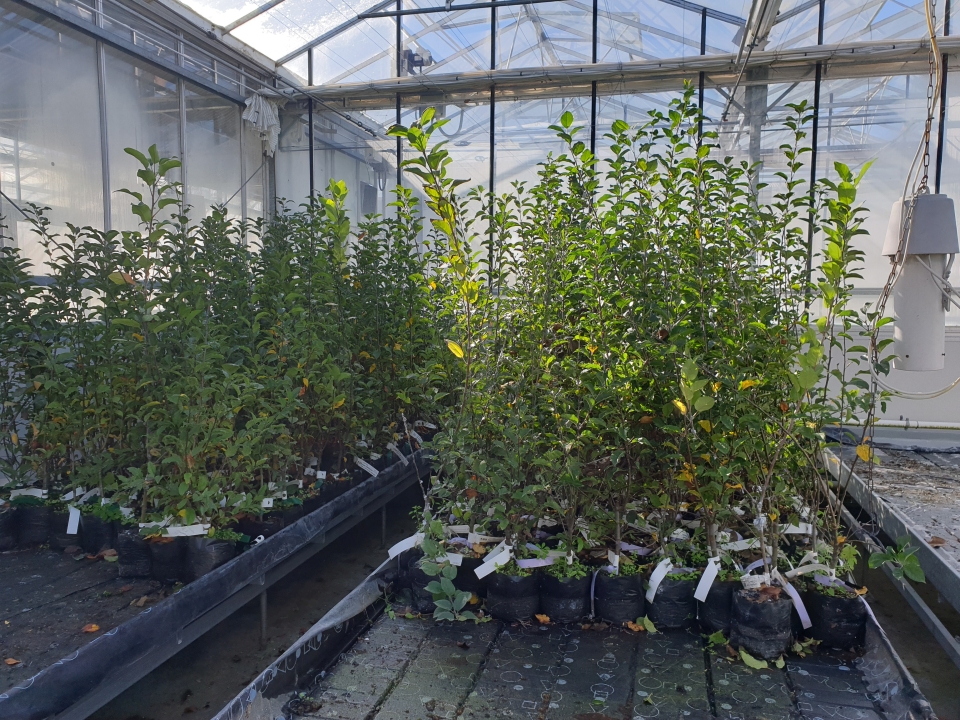You can contact LEARNZ, part of CORE Education, at:
Postal Address:
PO Box 13 678,
Christchurch 8141,
New Zealand
<- Homepage: Our Primary Industries: Unpacking the apple story
Photos appear here each day from the Diaries from Our Primary Industries - unpacking the apple story. Hover over each photo for a full description.
Other pages with photos:

Anna, Jim and Shelley talk to students from Pukekohe Intermediate School during the last field trip web conference. Image: Andrew Penny, LEARNZ.

This is the brown marmorated stink bug (BMSB). If this bug gets established in New Zealand it will be a major threat to our primary industries. Image: MPI.

These are green vegetable stink bugs. Why do you think scientists are studying these bugs? Image: Shelley Hersey, LEARNZ.

This drone is used to release sterile codling moths over orchards. You can see the white plastic pod where the moths will be released from. Image: Shelley Hersey, LEARNZ.

This sticky trap is used to monitor the presence of codling moths in orchards. Image: Shelley Hersey, LEARNZ.

These are sterile codling moths used to reduce the viable population of this pest species. Image: Shelley Hersey, LEARNZ.

This apple has been affected by a type of rot. How do scientists identify the cause of this rot? Image: Shelley Hersey, LEARNZ.

Matt looks at a sample of apple rot under the microscope to identify the type of fungus or bacteria present. Image: Shelley Hersey, LEARNZ.

Inside the Rockit™ apple pack house. What makes these apples unique? Image: Shelley Hersey, LEARNZ.

The ambassadors check out some packaged Rockit™ apples. Why do you think these apples are packaged in this way? Image: Shelley Hersey, LEARNZ.

Shelley, Chrissy and Vincent talk to students from Tamatea Intermediate School during the live web conference. Image: Andrew Penny, LEARNZ.

Chrissy shows you how to get the pollen from a flower so it can be used to fertilise another flower. Why would scientists want to do this? Image: Shelley Hersey, LEARNZ.

Chrissy shows you the Braeburn and Royal Gala apple parents that were crossed to produce Lemonade, Jazz and Envy apple varieties. Image: Shelley Hersey, LEARNZ.

These apple rootstocks have been bred to be resistant to disease. Image: Shelley Hersey, LEARNZ.

The rootstock on the left is resistant to woolly apple aphid while the one on the right is not. How does this aphid affect apple trees? Image: Shelley Hersey, LEARNZ.

You can see where an apple tree bud has been grafted on to this rootstock. Why are rootstocks used? Image: Shelley Hersey, LEARNZ.

Hannah tests the firmness of an apple. What is firmness a sign of? Image: Shelley Hersey, LEARNZ.

Hannah uses a syringe to collect a sample of ethylene gas from an apple. Why is Hannah interested in how much ethylene the apple is producing? Image: Shelley Hersey, LEARNZ.

In the future apple trees might be trained to grow along wires rather than branch out. Why might this be useful? Image: Shelley Hersey, LEARNZ.

This sensor measures the amount of sunlight that reaches leaves on the apple tree. Why is this information useful? Image: Shelley Hersey, LEARNZ.

At this trial orchard different growing methods are being tested. You can see how these trees have been attached to wires to keep branches growing in line. Why would it be helpful to grow fruit trees like this? Image: Shelley Hersey LEARNZ.

These apple trees are attached to a V-shaped trellis to make it easier to pick apples and increase air flow and exposure to sunlight. Fallen apples are composted to return nutrients to the soil. Image: Shelley Hersey, LEARNZ.

Some apples have not been harvested because they ripened too late or were not of a high enough quality. What do you think happens to these apples? Image: Shelley Hersey, LEARNZ.

Once apples are picked and placed in bins they are moved to a cool store until they can be packed. Image: Shelley Hersey, LEARNZ.

Apples are tipped from bins into water where they float through to the pack house. Why do you think the apples are placed in water? Image: Shelley Hersey, LEARNZ.

Apples float in freshwater through to the pack house. Image: Shelley Hersey, LEARNZ.

Inside the pack house apples are graded according to weight, size and colour. Image: Shelley Hersey, LEARNZ.

Apples are placed in moulded paper trays and packed into cardboard boxes ready for export. Image: Shelley Hersey, LEARNZ.

Apples are stored in a cool store at a temperature of 0.5 degrees Celsius. Why do they need to be kept this cold? Image: Shelley Hersey, LEARNZ.

Shelley and Duncan try some different apple varieties. Image: Andrew Penny, LEARNZ.

It was a stunning day to be flying. You could watch the surf roll in along the east coast. Image: Shelley Hersey, LEARNZ.

Kā Tiritiri o te Moana, the Southern Alps glistened with a layer of fresh snow. Image: Shelley Hersey, LEARNZ.

It was a smooth descent into Wellington where you enjoyed a break before heading north to Napier. Image: Shelley Hersey, LEARNZ.

You flew out over the Hutt Valley on your way to Napier. Image: Shelley Hersey, LEARNZ.

You could see plenty of vineyards and orchards on your approach into Napier. Image: Shelley Hersey, LEARNZ.

This is the Port of Napier where some apples begin their export journey across the world. Image: Shelley Hersey, LEARNZ.

You ended the day with a walk up Te Mata Peak where you could look out over fertile plains where apples are grown. Image: Shelley Hersey, LEARNZ.

On the way back to your accommodation you headed to the supermarket. There were lots of different apple varieties to choose from. Image: Shelley Hersey, LEARNZ.